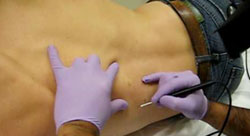Moles are raised dark blots that usually appear on the skin. They tend to develop due to elevated accumulations of melanin but are common and harmless. Nonetheless, sometimes they grow large in size and when noticeable, people prefer removing them quickly. The process can be quick and inexpensive if done properly. One thing to keep in mind is that mole removal might inevitably leave a scar depending on the size of the mole. The procedure usually requires making an incision which later needs to be stitched, (again depending on the size of the mole). Once the stitches are removed, though the mole may be gone, a small scar may remain.

Scars After Mole Removal
When dermatologists perform mole removals, they usually make use of older techniques that require them to cut out and burn the moles. Although this technique has been around for a while, it doesn’t make it ineffective. The truth is, every mole removal will most likely leave some kind of a scar. At times they might be small and even unnoticeable but if the mole removed was large, a visible scar may show. When a mole is removed it’s usually cut off the skin. Not in every case will there be an incision, though. In radio wave treatment or laser treatment, there are no open wounds and no need for incisions! Don’t forget too that after the procedure you must take proper care of the wound in order to prevent infection.
Minimize Scarring
Any physician or dermatologist will acknowledge that it is impossible to make a surgical incision and avoid leaving a scar. Nevertheless, there are a few techniques that they use when performing mole removal procedures to minimize scarring. For example, some dermatologists choose to align scars along the natural flaps of the skin in order to disguise scarring. Dermatologists recommend avoiding intake of aspirin before and after the removal procedure. There are other mole removal techniques that you can try before surgery including shave removal or laser procedures that will leave smaller scars than excision does. In addition, a few dermatologists like to close the cut with a deep level of dissolvable stitches, plus a superficial level of regular stitches (which will be removed after 5 days), which will get all of the skin edges to heal up together perfectly.
Mole Removal Aftercare
Even though no matter what you do, there will most likely be some type of scar, the appropriate care of the wound after surgery is essential to minimizing scarring. If you take proper care of your wound then you’ll not only reduce scarring but you’ll prevent infection that could scar you worse than the actual incision! Some guidelines given to patients after a removal procedure include:
- Replacing bandages frequently, and maintaining the wounded area
- Drinking a lot of water in order to prevent dehydration and dry skin (moisturized skin is harder to scar)
- Applying creams that prevent scarring (consult with your physician on which one you should use)
- Avoid extended sun exposure
